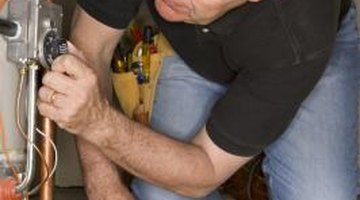Why Do Bottom Feed Water Heaters Need Vacuum Breaker?
Some tank-less electric water heaters admit cold water from the bottom of the appliance into a chamber that holds an electric heating element. The element heats the water quickly as it passes through and depends on the water to prevent overheating. Vacuum breakers prevent water from draining out of the chamber when low water pressure occurs. Other types of bottom-feed water heaters need vacuum breakers to ensure hot water storage tanks stay full when water pressure falls.
Backflow Preventers

In most homes, water heaters admit cold water and supply hot water through separate fittings at the top of the storage tank. Siphon effects on both sides of the tank might cause back flow into the drinking water or drain water out of the tank, exposing heating elements. Other problems can occur when low water pressure siphons water out of a tank-less water heater. Tank-less electric heaters heat water on demand with an electric heating element designed for constant immersion in water. Air pockets in the tank-less heater's circulation chamber cause failures from overheating.
Tank-less Installations
Tank-less water heaters use less energy when located close to the point of use. A tank-less heater might supply hot water for an upstairs bathroom, easing demand on the basement hot water tank. After installation, running cold water through the heater with the unit off flushes air bubbles out of the system. Water remains in the heater as long as pressure stays positive. On a well system with a pressure tank, using water downstairs during a power outage creates negative water pressure upstairs. A vacuum breaker on the supply side interrupts the siphon effect that would otherwise drain the heater.
Output Problems
On the output side of the heater, an open faucet located lower than the heater lets water out when water pressure drops. Installing a vacuum breaker on the outlet side, in a loop of pipe that rises higher than the tank, prevents water from draining through the lower outlet. The weight of water in the open output line opens the vacuum breaker valve, admitting air. Only the water in the line past the vacuum breaker drains out. To be safe, turn the tank-less heater off during low-pressure problems. Run water through the system to flush out air bubbles before restoring the heater's power.
Heat Exchangers
Heat exchanger systems, including passive solar water heaters, heat water in one location and store hot water in a separate tank. Some heat exchange systems connect to existing hot water tanks through special adapter valves attached to the tank's bottom drain outlet. If any fixture on the output side of the tank opens at a lower level than the heater or the storage tank, an open fixture can drain the system during pressure failures. Only a vacuum breaker at the top of an upright loop in the output line, higher than any part of the supply system, can prevent siphoning failures, according to Plumbing/Mechanical Inspections Supervisor Jay Mundy.
References
Writer Bio
James Young began writing in 1969 as a military journalist combat correspondent in Vietnam. Young's articles have been published in "Tai Chi Magazine," "Seattle Post-Intelligencer," Sonar 4 ezine, "Stars & Stripes" and "Fine Woodworking." He has worked as a foundryman, woodturner, electronics technician, herb farmer and woodcarver. Young graduated from North Seattle Community College with an associate degree in applied science and electronic technology.
Photo Credits
- Jupiterimages/liquidlibrary/Getty Images
More Articles



